How to Increase Brand Awareness with an Expert Consultant, Not a Bloated Agency
- Chase McGowan

- 3 days ago
- 16 min read
Trying to build brand awareness by just shouting louder than everyone else is a fast way to burn through your budget with an overpriced agency. Real, lasting brand recognition comes from being the voice people actually trust. It’s about building genuine authority through consistent, authentic messaging on the right channels—creating a presence that’s both memorable and reliable.
Build Trust, Not Just Impressions
So many businesses fall into the agency trap. They pay hefty retainers for generic services from bloated firms that chase impressions but do absolutely nothing to build real authority. It’s a volume game for them, driven by the flawed assumption that a bigger budget automatically equals a bigger impact. This scattergun approach just wastes your money pushing messages to people who aren’t even listening.
Your goal shouldn't be to just get your name out there; it's to become a trusted resource. Today’s consumers are smart. They can spot inauthentic, cookie-cutter marketing from a mile away and are sick of being sold to. They want to connect with brands that offer real value and prove their expertise, day in and day out.
The New Currency of Brand Awareness
Authenticity and consistency are the cornerstones of modern brand-building. Instead of launching broad, expensive campaigns that blanket the internet, a focused strategy delivers a clear, reliable message to a very specific audience. This is exactly where working with a dedicated consultant—an individual expert—makes all the difference.
Unlike a bloated agency where your account is just one of dozens, I invest the time to truly understand your unique value. I craft a strategy that’s nimble, precise, and centered on building a genuine connection. This isn't about running your account through a one-size-fits-all template; it's about becoming an extension of your team.
The core difference is strategic depth versus operational scale. An agency is built to scale processes; an individual consultant like myself is built to deepen expertise. You get a partner dedicated to your success, not a junior account manager following a generic playbook.
The right partner understands that building a brand is a cycle, not a one-off event. It’s a process of earning trust through repetition, which eventually leads to the kind of brand recognition that sticks.
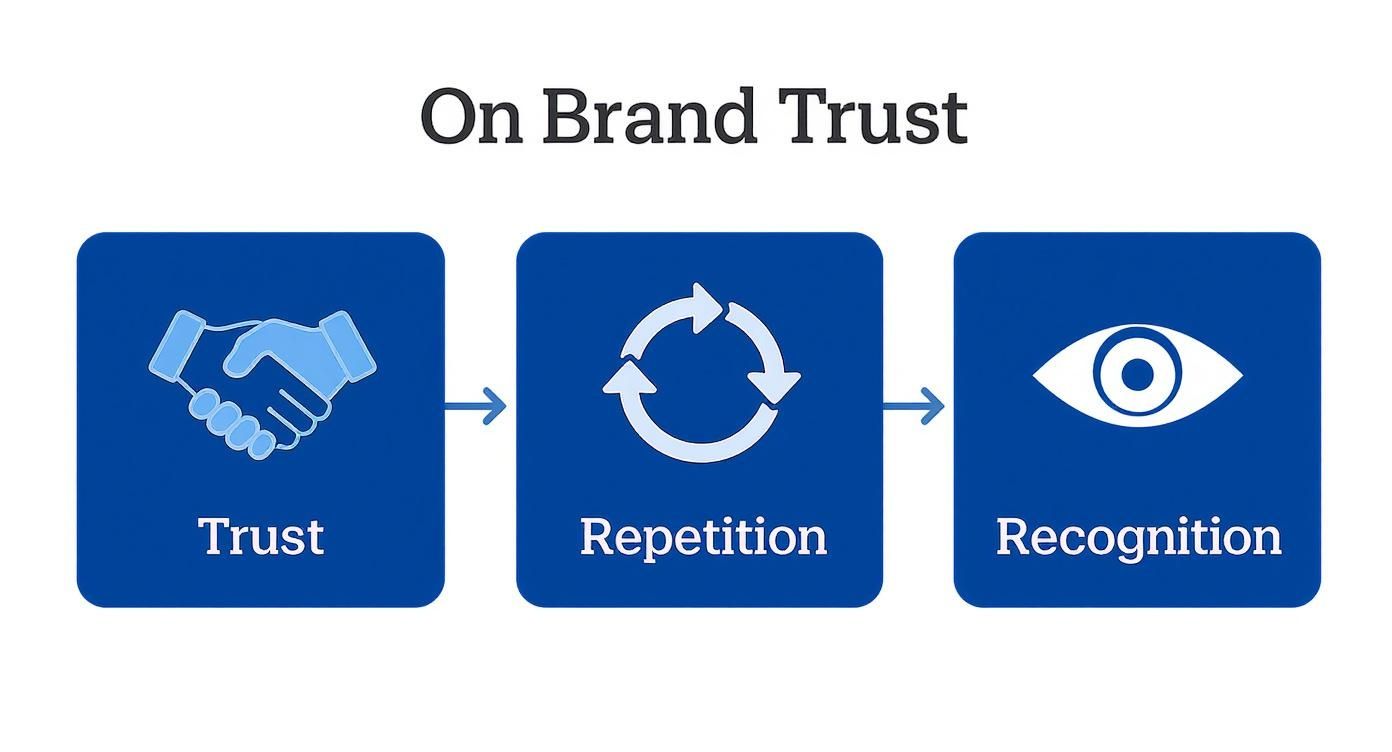
As you can see, true brand awareness is the outcome of a deliberate process, not a happy accident.
When you’re deciding on a partner to help build your brand, the choice often comes down to an individual expert versus a large, process-driven agency. Here’s a quick breakdown of how those two options really stack up.
Individual Consultant vs Bloated Agency for Brand Building
Attribute | Individual Google Ads Consultant | Large Marketing Agency |
|---|---|---|
Strategic Focus | Deep, customized strategy based on your specific business goals. | Standardized playbooks and templates applied across many clients. |
Point of Contact | Direct access to me, the senior expert working on your account. | Communication filtered through a junior account manager. |
Agility | Quick to pivot and adapt strategy based on real-time data. | Slow, bureaucratic processes hinder rapid changes. |
Expertise | Specialized, hands-on knowledge in Google Ads from an individual expert. | Generalist teams with diluted expertise; senior talent is rarely hands-on. |
Cost Structure | Transparent pricing focused on delivering value, not overhead. | High retainers loaded with overhead, management fees, and inefficiencies. |
Accountability | My reputation is directly tied to your results. | Diffused responsibility across a large team; easy to pass the buck. |
The takeaway is clear: if you want a strategy tailored to your brand's unique needs and a partner who is genuinely invested in your success, a specialized consultant is the smarter choice. Agencies are built for scale; consultants are built for impact.
Trust as a Prerequisite for Purchase
The data backs this up completely. Building trust isn't just a nice-to-have; it's now the foundation of brand awareness. A decisive 81% of global consumers say they need to trust a brand before they even think about making a purchase.
This trust is earned through consistent messaging and reliability over time. It takes an average of six to seven impressions for a brand to truly take hold, which reinforces the need for repeated, authentic exposure across carefully chosen channels—not just a single clever ad. You can find more brand awareness statistics and insights on amraandelma.com.
Ultimately, creating trust is the most direct and efficient path to increasing brand awareness.
Using Google Ads to Build Your Brand
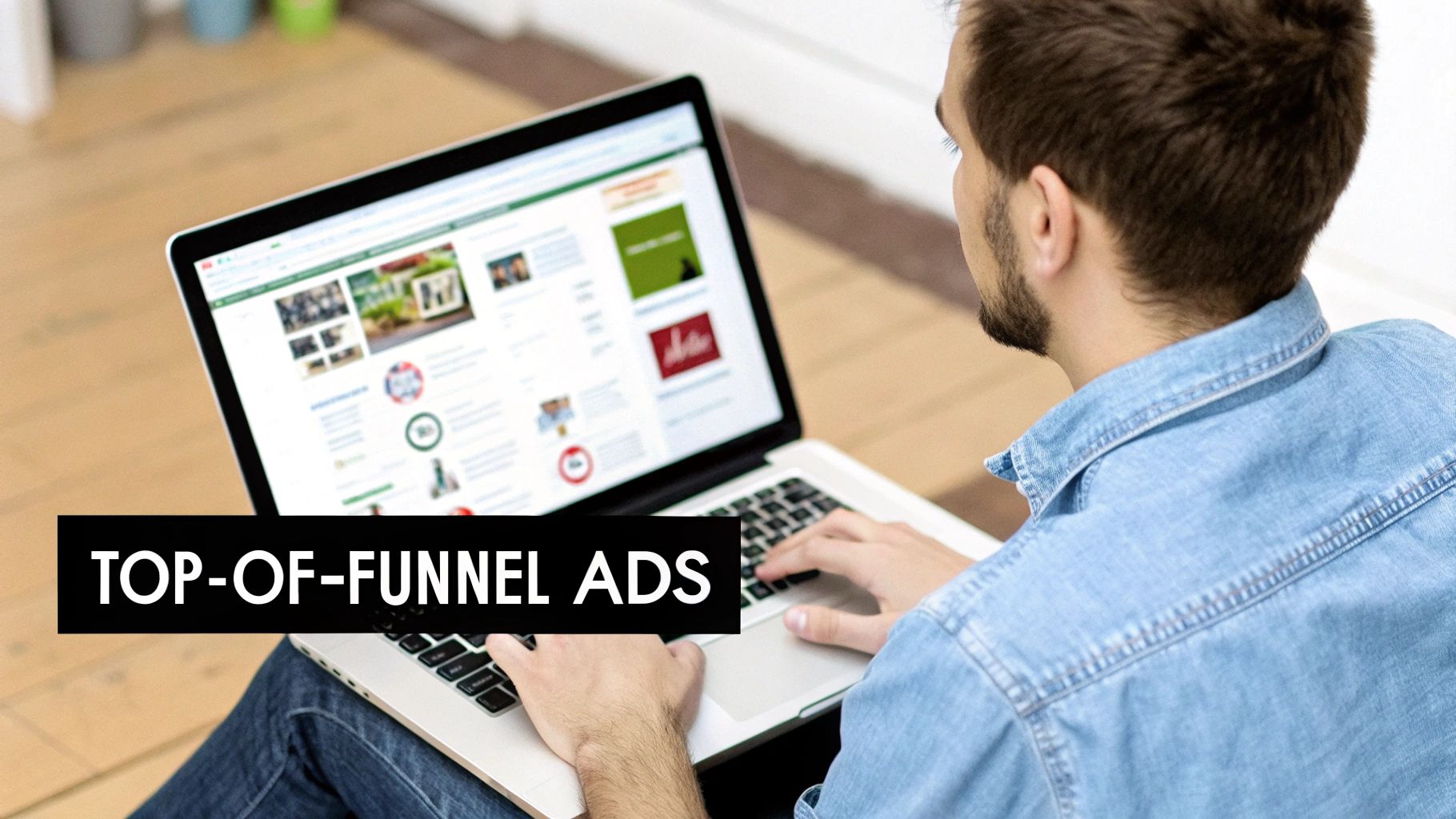
When you look at paid advertising for brand awareness, the gap between a seasoned consultant and a big agency is massive. Agencies tend to treat brand building as an afterthought, often just bundling it into their existing conversion campaigns where it gets completely ignored. This is a lazy, inefficient, and frankly, a fast way to burn through your budget on clicks that go nowhere.
As a specialist, I know that brand awareness is its own beast. The goal isn't just clicks; it's about strategically getting your brand in front of the right people before they even know they have a problem you can solve. I build familiarity and trust at the very top of the funnel with surgical precision. This demands a dedicated strategy, not just another box to check on a campaign setup form.
The Problem with the Agency Approach
Big agencies are built on scale and templates. When they say they're running a "brand awareness" campaign, it usually means they've selected "Awareness" as the campaign goal and are letting Google's algorithm take the wheel. They'll throw up a few generic display ads, call it a day, and then report on vanity metrics like impressions that do nothing for your bottom line.
This is where the bloat and inefficiency kill you. Your account is likely being handled by a junior manager juggling a dozen other clients, with zero time or incentive to actually dig into what makes your audience tick. Creative testing is slow, budget tweaks are rare, and strategic thinking is non-existent. You end up paying a premium for a standardized, low-effort service.
The real issue is that agencies sell scale, not expertise. My value as a consultant is my direct, hands-on ability to build and fine-tune campaigns with a level of detail an agency structure just can't handle. You aren't just another account number; you're a strategic partner.
This difference in approach becomes painfully obvious when you see how a specialist actually uses the tools inside Google Ads.
Crafting High-Impact Display Ads
The Google Display Network (GDN) can reach over 90% of internet users worldwide. It’s an incredibly powerful tool for awareness, but most agencies use it poorly. They churn out bland, static ads that people have been conditioned to ignore for years. As an expert, I know a winning Display campaign is all about grabbing attention and sparking an emotional connection.
This means moving beyond stock photos and generic copy. I create multiple ad variations with eye-catching visuals, a clear value prop, and calls-to-action that match an awareness goal—think "Learn More" instead of "Buy Now." I'm constantly testing different headlines, images, and color schemes, using the data to quickly double down on what resonates. An agency might test creative once a quarter; I'm doing it weekly.
Tapping Into YouTube for Cost-Effective Reach
YouTube is the second-biggest search engine in the world, making it a goldmine for brand awareness if you know what you're doing. A lot of agencies avoid it because video creative seems like a hassle, or they just default to expensive, skippable in-stream ads that most users can't wait to skip.
As a specialist, I see the real opportunity in the more cost-effective formats that are built for awareness.
Bumper Ads: These are six-second, unskippable ads that are perfect for delivering a quick, memorable message. They’re priced on a cost-per-thousand-impressions (CPM) basis, which makes them incredibly affordable for getting in front of a huge audience.
Non-Skippable In-Stream Ads: When your message is a bit longer (up to 15 seconds), these ads guarantee your whole story gets told. They work best when the creative is punchy and gets straight to the point.
The trick is matching the ad format to the campaign goal. As a consultant, I can nimbly build and manage a mix of these formats, testing different video clips to see which ones drive the best brand lift and recall, all while keeping costs firmly in check.
Finding Your Audience Before They Find You
This right here is the biggest differentiator. Agencies often settle for broad demographic targeting. As a consultant, I use Google’s powerful audience-building tools to find your ideal customer with incredible accuracy. This is where deep platform knowledge really pays off.
I can build hyper-targeted audiences based on:
In-Market Segments: People who are actively researching products or services just like yours.
Affinity Audiences: Users with a proven, long-term interest in topics relevant to your brand.
Custom Audiences: These are created by feeding Google specific keywords, competitor website URLs, or even apps your target audience uses. Imagine showing your ads only to people who visit your top three competitors' websites. That’s the level of precision we’re talking about.
This proactive targeting ensures your budget is only spent introducing your brand to people who are highly likely to become customers later on. To really get into the weeds on these powerful techniques, check out our detailed consultant's guide to Google Ads audience targeting.
At the end of the day, using Google Ads for brand awareness is a craft. It takes a specialist who can blend creative strategy with deep technical knowledge to manage campaigns efficiently and effectively. This nimble, expert-led approach consistently beats the slow, generalized model of a bloated agency, delivering far better results for a fraction of the cost.
Connecting Content Marketing with Precision PPC
Paid ads get your brand seen, but great content gets your brand remembered. The real magic happens when you stop treating them as separate channels and build a powerful feedback loop where one constantly fuels the other.
This is exactly where most big, bloated agencies completely drop the ball.
Their PPC and content teams live in different departments, sending separate reports and rarely talking strategy. The ad managers obsess over clicks, the writers track page views, and a massive opportunity gets lost right in the middle. The result? Wasted ad spend on content that doesn't connect and great content that never finds its audience.
The Consultant Advantage: A Unified Strategy
I don't have silos. As a consultant, I'm the one connecting the dots, managing the entire process from analyzing raw ad data to shaping the next piece of content. This creates an intelligent, nimble system where every dollar and every word works harder for you.
When I see a particular ad group targeting a specific pain point getting unusually high engagement, that’s not just an ad metric to me. It's a flashing green light telling us exactly what our next blog post or video needs to be about.
On the flip side, once we publish a well-researched article, I can immediately spin up a targeted ad campaign to get it in front of the exact people who need that information right now.
This closed-loop system is the key differentiator. Instead of two separate teams following their own playbooks, you get one expert strategist connecting ad insights to content creation and using valuable content to fuel ad performance.
This agile, integrated approach is something large agencies, with their rigid structures and layers of management, simply can't replicate.
Turning Ad Insights into Authoritative Content
The first step is to use your PPC campaigns as a real-time research tool. Your Google Ads account is a goldmine of data—it tells you what your audience is searching for, the language they use, and which hooks grab their attention.
As an expert consultant, I know how to dig into this data to find content opportunities.
Mine Search Query Reports: I hunt for recurring questions and long-tail keywords that signal a user is looking for a real solution, not just a product. A query like “how to choose accounting software for a small business” is the perfect seed for a comprehensive guide.
Spot High-Performing Ad Copy: If a specific headline or description drives a killer click-through rate, it means the message is hitting a nerve. That exact language should be the foundation of a deeper-dive blog post or video script.
Watch Audience Segments: See that an "in-market audience" for a particular product category is responding well to your ads? That's your cue. The next logical step is to create top-of-funnel content that answers their early-stage research questions.
Using this data-first approach, you stop guessing what to create and start building resources you know your audience is actively looking for. This is how you build real authority and become the go-to name in your space.
Promoting Your Content with Surgical Precision
Creating amazing content is only half the battle. If no one sees it, it does nothing for your brand. This is where precision PPC comes back into the picture. Instead of just crossing our fingers for organic traffic, we actively push your content to hyper-targeted audiences.
Google Ads gives us the perfect tools for the job.
Display Ads: We can create visually compelling ads that promote your latest article and place them across websites your ideal customers visit every day.
Discovery Campaigns: These ads appear natively in Google's Discover feed, YouTube, and Gmail, introducing your helpful content to people based on their established interests and online behavior.
YouTube Ads: If your content is a video, we can run incredibly cost-effective campaigns to get it in front of viewers who are already watching content in your niche.
The goal here isn't a direct sale. It's about providing value and making a powerful first impression. This strategy establishes your brand as a helpful expert, making it far more likely that people will remember you and come back when they're finally ready to buy.
Of course, this approach only works if your content sends users to a well-designed page. To learn more, check out our guide on [landing page design best practices that beat bloated agencies](https://www.cometogether.media/single-post/landing-page-design-best-practices-9-tips-to-beat-bloated-agencies). By connecting every piece of the puzzle, a focused consultant ensures your content and ads work in sync to build meaningful brand awareness that actually lasts.
Getting Your Brand Seen on Social Media (Without Lighting Your Money on Fire)
Social media can feel like a black hole for your marketing budget. Big agencies love to sell the dream of being everywhere at once—a strategy that pads their invoices but almost never delivers real results. It’s a classic case of prioritizing activity over actual impact.
The smart play isn’t about blanketing every platform with generic posts. It’s about surgical precision. Instead of spreading your budget thin across five different channels, as a specialist consultant, I help you zero in on the one or two places where your customers are actually spending their time.
This is the difference between an agency assigning a junior staffer to schedule posts and a consultant digging deep to find out if your B2B buyers are debating trends on LinkedIn or if your ideal customers are pinning their dream purchases on Pinterest. One is busywork; the other is strategy.
Go Deep, Not Wide
The objective here is to become part of the conversation, not just another brand shouting into the void. A focused strategy lets you build real connections in a way a broad, templated approach simply can't. It means creating content that feels native to the platform, not just repurposed from somewhere else.
A quick, text-only post on LinkedIn sharing a sharp insight from a recent project will almost always outperform a lazy link to your latest blog with a “check it out” caption. Why? It delivers immediate value and respects the user's context.
Agencies are built to execute standardized tasks at scale. A consultant is built to apply nuanced, strategic thinking to every action. This means less wasted effort on platforms that don't matter and more meaningful engagement where it counts.
This focused approach lets you jump into relevant discussions, answer questions directly, and build the kind of relationships that turn followers into genuine brand advocates.
The Untapped Power of Social Listening
One of the most valuable tools in the social media playbook is social listening, and most brands barely scratch the surface. This isn't just about tracking mentions of your own brand name. It's about tuning into the conversations happening around your industry, your competitors, and the problems your audience is trying to solve.
An agency might send you a simple monthly report of your brand mentions. As a consultant, I use social listening as a real-time intelligence-gathering tool.
Find Content Goldmines: Pinpoint the questions your audience is asking that nobody else is answering. This is where your most authoritative content ideas will come from.
Gauge the Vibe: Get a raw, unfiltered look at how people really feel about industry trends or a competitor’s new launch. This insight is crucial for nailing your messaging.
Spot Opportunities to Engage: Discover conversations where you can add real value without a sales pitch, building trust and positioning yourself as the go-to expert.
You can’t get this level of insight by just scheduling posts from a content calendar. It takes an expert who’s actively trying to understand the market, not just checking boxes.
Amplify Your Core Message
Finally, your social media activity can’t live on an island. It should be the amplifier for your best content and your most precise PPC campaigns, creating a message that feels consistent and powerful everywhere your audience sees it.
Once you’ve published a killer blog post (ideally one informed by your PPC data), a focused social strategy ensures it doesn't just sit there.
Craft a LinkedIn Article: Pull the main arguments into a native article to tap into your professional network.
Create a Twitter Thread: Break down the key stats and takeaways into a bite-sized, shareable thread.
Design a Simple Graphic: Turn the most compelling data point into a visual for platforms like Instagram or even back on LinkedIn.
This approach is nimble, efficient, and makes every piece of content work harder. It’s the kind of smart, integrated thinking you get from a dedicated expert, not a siloed agency team.
Measuring Brand Awareness That Actually Matters
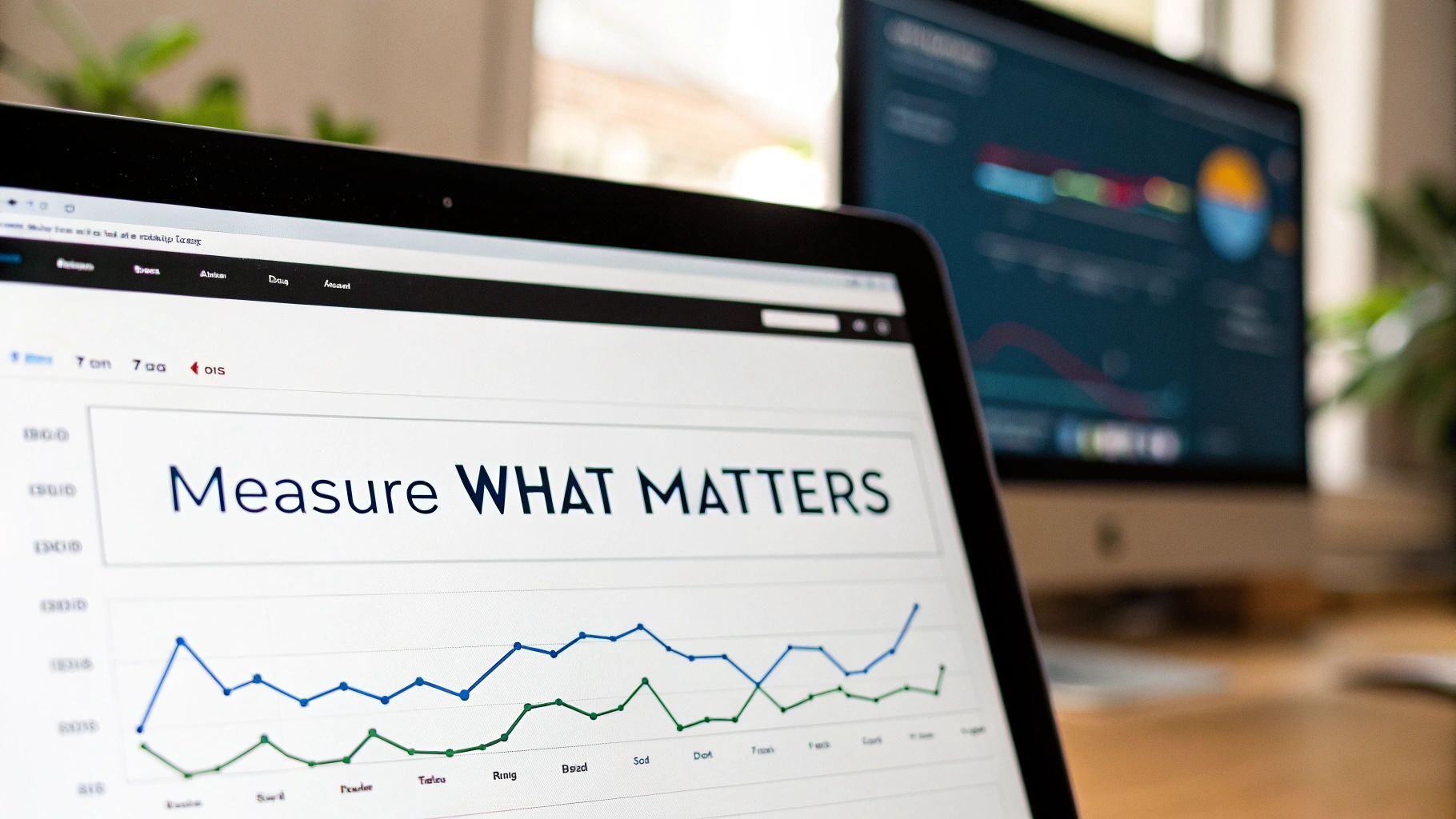
So, how do you know if all this brand awareness work is actually paying off?
This is where the rubber meets the road—and where you see the huge difference between a dedicated consultant and a bloated agency. Agencies love to hide behind vanity metrics. They’ll throw around massive numbers for "impressions" and "reach" because they look great on a slide, but they tell you almost nothing about your actual business.
An impression just means your ad flashed on a screen somewhere. It doesn't mean anyone noticed, remembered, or will ever buy from you. My reputation is tied directly to your results, which means I focus on tracking the metrics that prove we’re building a real asset, not just making noise.
We have to get past the fluff and measure the things that are leading indicators of future growth. It's about direct accountability—a level of transparency you just don't get when reports are filtered through layers of agency management.
Moving Beyond Agency Vanity Metrics
The fundamental problem with agency-style reporting is that it celebrates activity, not outcomes. Showing you a chart with millions of impressions is easy. It completely sidesteps the only question that matters: did anyone actually care?
A consultant's approach is different. I zero in on metrics that show a real change in how people behave. I'm looking for proof that people aren't just seeing your brand, but are now actively seeking it out. That shift in measurement is how you prove the ROI on your investment.
To make sure your efforts are actually working, it's critical to use expert brand awareness measurement strategies.
The whole philosophy is simple: measure what matters. An agency might brag about a campaign that reached a million people. I celebrate a campaign that caused a 20% increase in people searching for your brand by name. One is a vanity metric; the other is a direct signal of growing brand equity.
This focus keeps us honest and ensures we're investing your budget, not just spending it.
The Metrics That Signal Real Growth
So, what should you be looking at instead? Forget the confusing, multi-page reports. A simple, powerful dashboard with a few key KPIs tells the entire story.
These are the metrics I watch like a hawk for my clients:
Branded Search Volume: This is the gold standard, period. You can find it in Google Search Console. When more people are typing your company name directly into Google, it’s undeniable proof that brand recall is growing. You're no longer just another option; you're becoming a destination.
Direct Website Traffic: Tracked in Google Analytics, this shows you who typed your URL straight into their browser. A rising number of direct visitors means people remember who you are and are coming right to you. That’s top-of-mind awareness in action.
Share of Voice: Using social listening tools, you can measure how often your brand is mentioned online compared to your competitors. Are you capturing more of the conversation in your industry? A growing share of voice means you're becoming a more relevant and dominant player.
These aren't just numbers on a screen; they are the pulse of your brand's health. For a deeper dive into connecting these efforts to real outcomes, check out our guide on [how to measure advertising effectiveness](https://www.cometogether.media/single-post/how-to-measure-advertising-effectiveness).
Actionable Brand Awareness Metrics to Track
Forget the convoluted agency reports designed to justify their fees. A clear, actionable dashboard is all you need. Here’s a simple table outlining the KPIs that truly reflect brand awareness growth, moving you far beyond vanity metrics.
Metric | What It Measures | Tool to Use | Why It's Better Than Agency Metrics |
|---|---|---|---|
Branded Search Volume | The number of people searching for your brand name. | Google Search Console | Shows active interest and brand recall, not passive exposure like impressions. |
Direct Website Traffic | Visitors who type your URL directly into their browser. | Google Analytics | Measures top-of-mind awareness and brand loyalty; a direct signal of trust. |
Share of Voice | Your brand's percentage of industry conversations. | Social Listening Tools | Gauges market relevance and authority, not just the volume of your own posts. |
Referral Traffic Growth | Increase in traffic from other reputable sites and media. | Google Analytics | Proves your brand is earning trust and mentions from third parties. |
By tracking these specific KPIs, we connect every dollar spent on awareness to real, forward-looking indicators of business success. This isn't about shouting into the void; it's about systematically building an asset that will pay you back for years.
Your Brand Awareness Questions Answered
When you’re trying to figure out how to grow brand awareness, a ton of questions pop up. A big one is often whether to go with a dedicated consultant or a massive agency. Let's cut through the noise and tackle the common concerns I hear all the time.
How Much Should I Spend on Brand Awareness?
This is always the first question, but thinking in terms of a specific dollar amount is the wrong way to look at it. The real goal is efficiency.
Bloated agencies often push for high minimum ad spends because their business model depends on it—they take a percentage. For them, more spend equals more revenue, whether it's actually working for you or not. An independent expert flips that model on its head.
My approach is to find the minimum effective dose. What's the smallest investment we can make to see a real, measurable lift in metrics like branded search volume? We start lean, prove the concept with hard data, and only then do we scale the budget. This way, every dollar you spend is a calculated investment, not just a line item expense.
How Long Does It Take to See Results?
Let’s be clear: brand awareness is a long game. Anyone promising you overnight success is selling you snake oil and vanity metrics. Building genuine brand recall takes time and consistent exposure to your message.
You’ll likely see some early positive signs, like a jump in website traffic, within the first 90 days. But the metrics that really matter—like a significant increase in direct traffic and people searching for your brand by name—typically take 6-12 months of steady effort to materialize.
The advantage of working with a consultant is speed and agility. I’m not stuck in a rigid quarterly plan. We can adjust our strategy month-to-month based on what the data is telling us, which means we get to those meaningful results much faster than a slow-moving agency.
What Is the Biggest Mistake Businesses Make?
The most common and costly mistake I see is treating brand awareness as if it exists in a vacuum, completely separate from the rest of marketing. This is an agency specialty.
Their "awareness team" runs display ads while the "conversion team" runs search campaigns, and the two rarely, if ever, talk. It creates a jarring customer experience and burns through an incredible amount of money.
A winning strategy is a unified one. Insights from your performance campaigns must feed your awareness efforts, and vice versa. It’s a closed feedback loop that a siloed agency structure simply can’t create.
Is an Agency Safer Than a Consultant?
It’s easy to think a big agency is the "safe" bet just because of its size, but that’s usually not the case. When you hire an agency, you’re paying for their fancy office, their layers of management, and the salary of a junior account manager who is juggling a dozen other clients. The person actually doing the work has very little skin in the game.
With a consultant, my reputation is on the line with your results. You get a dedicated expert who is personally invested in seeing your brand grow and is directly accountable for every decision. That direct ownership is the most secure investment you can make.
For a deeper dive into the nuts and bolts of building a powerful brand presence, check out this comprehensive guide on increasing brand awareness.
Ready to build your brand with a strategy that delivers real results, not just reports? As an expert Google Ads consultant, Come Together Media LLC offers the specialized, hands-on approach that bloated agencies can't match. Schedule your free consultation today.




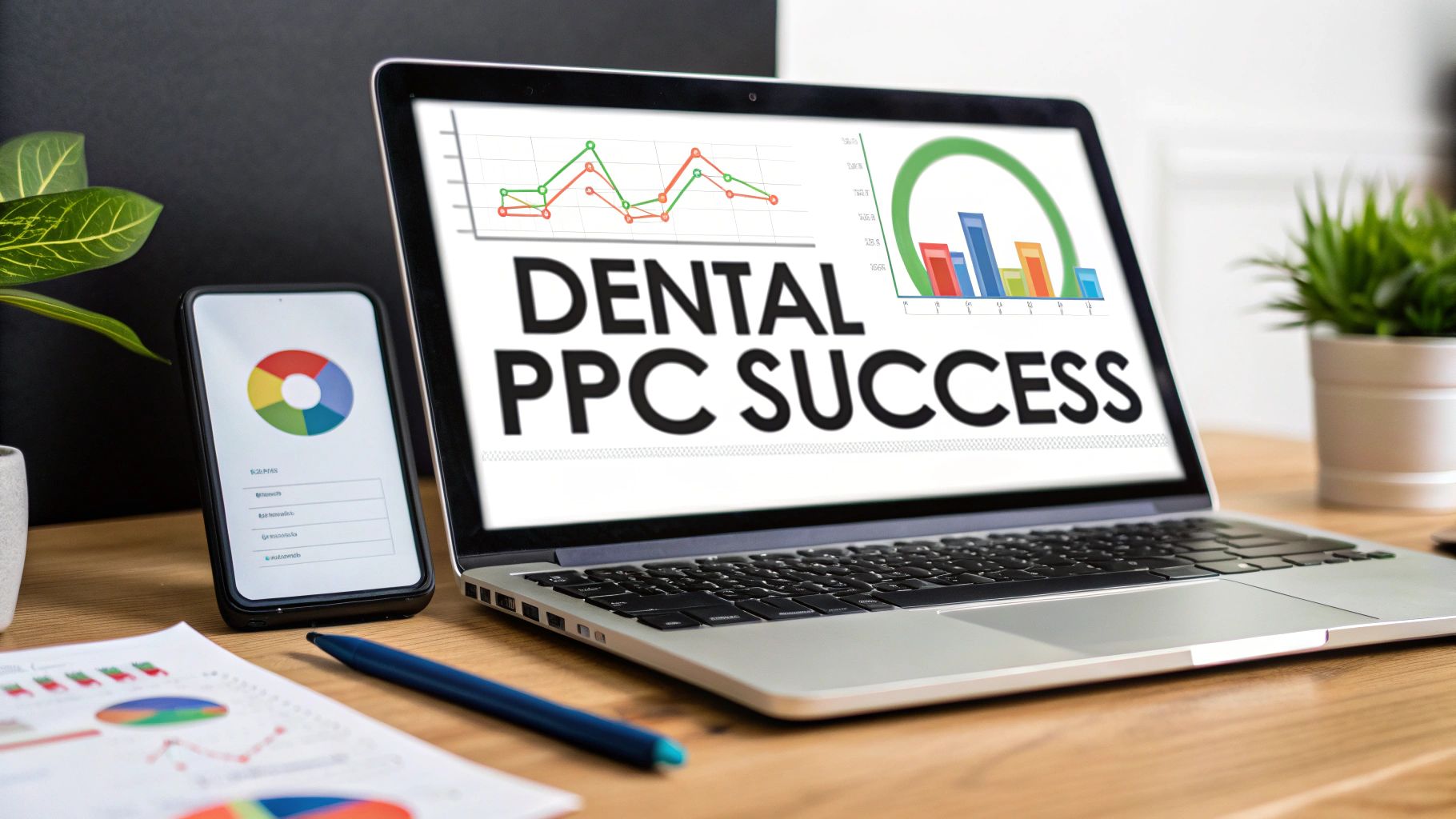
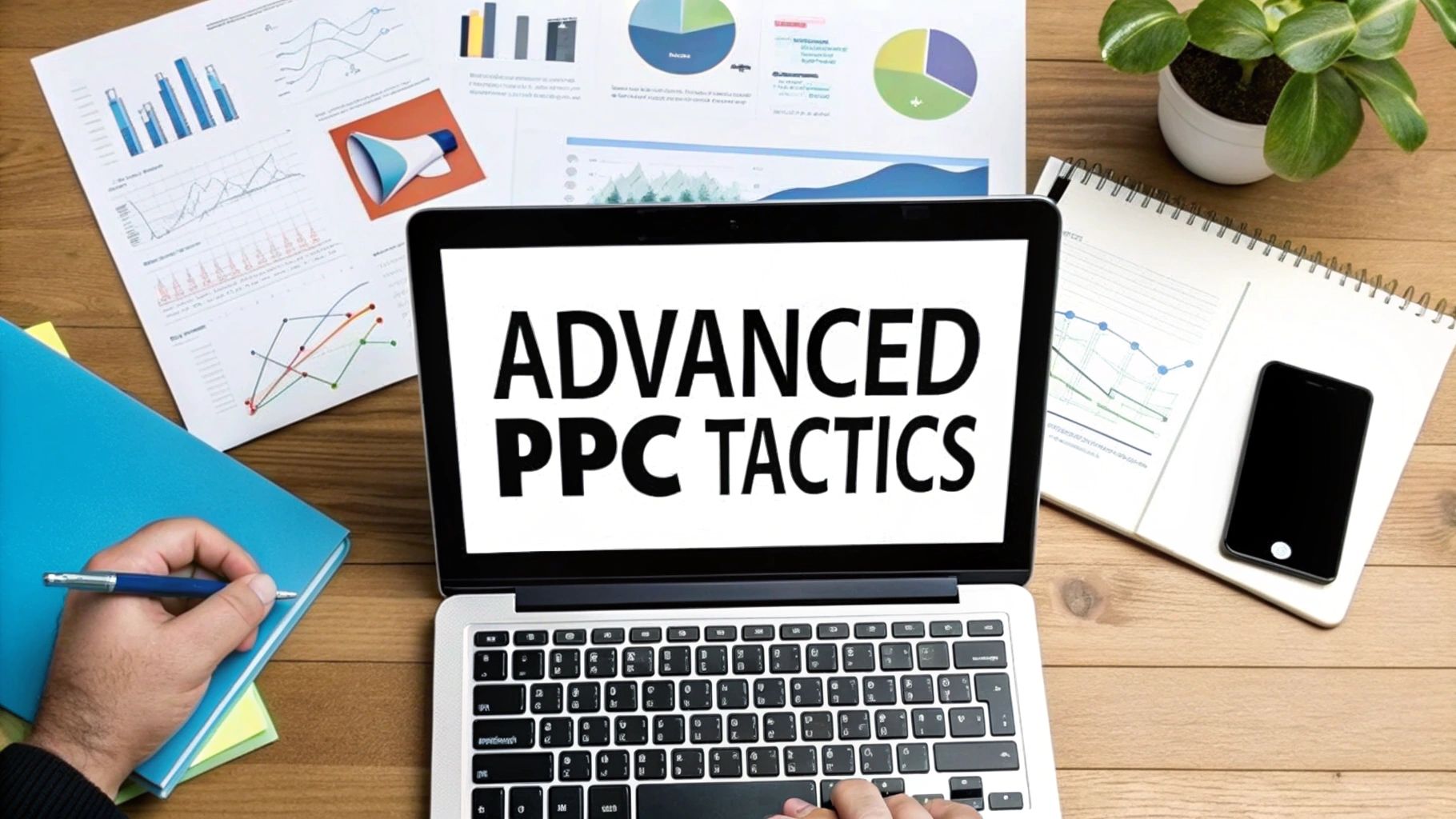
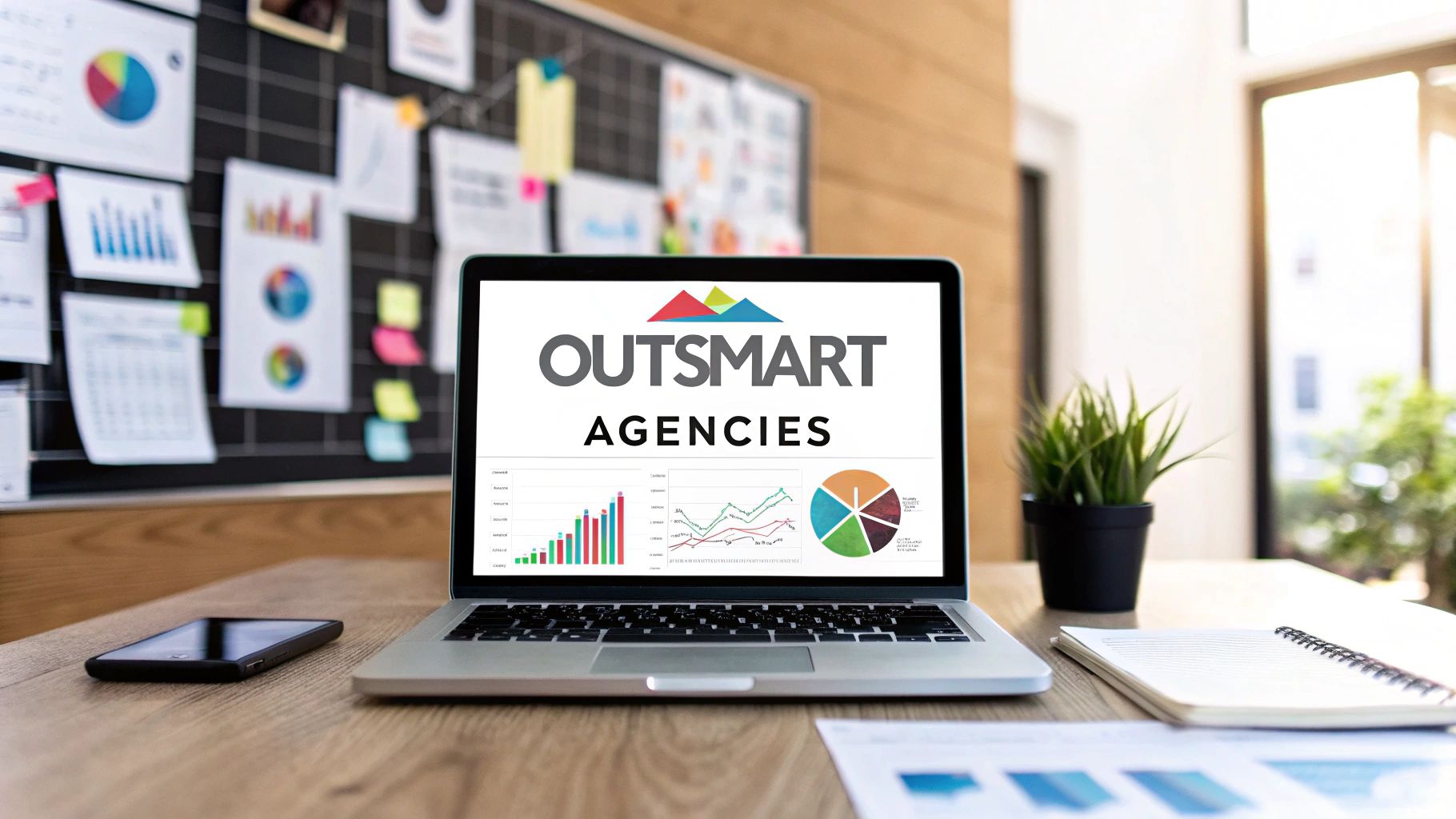
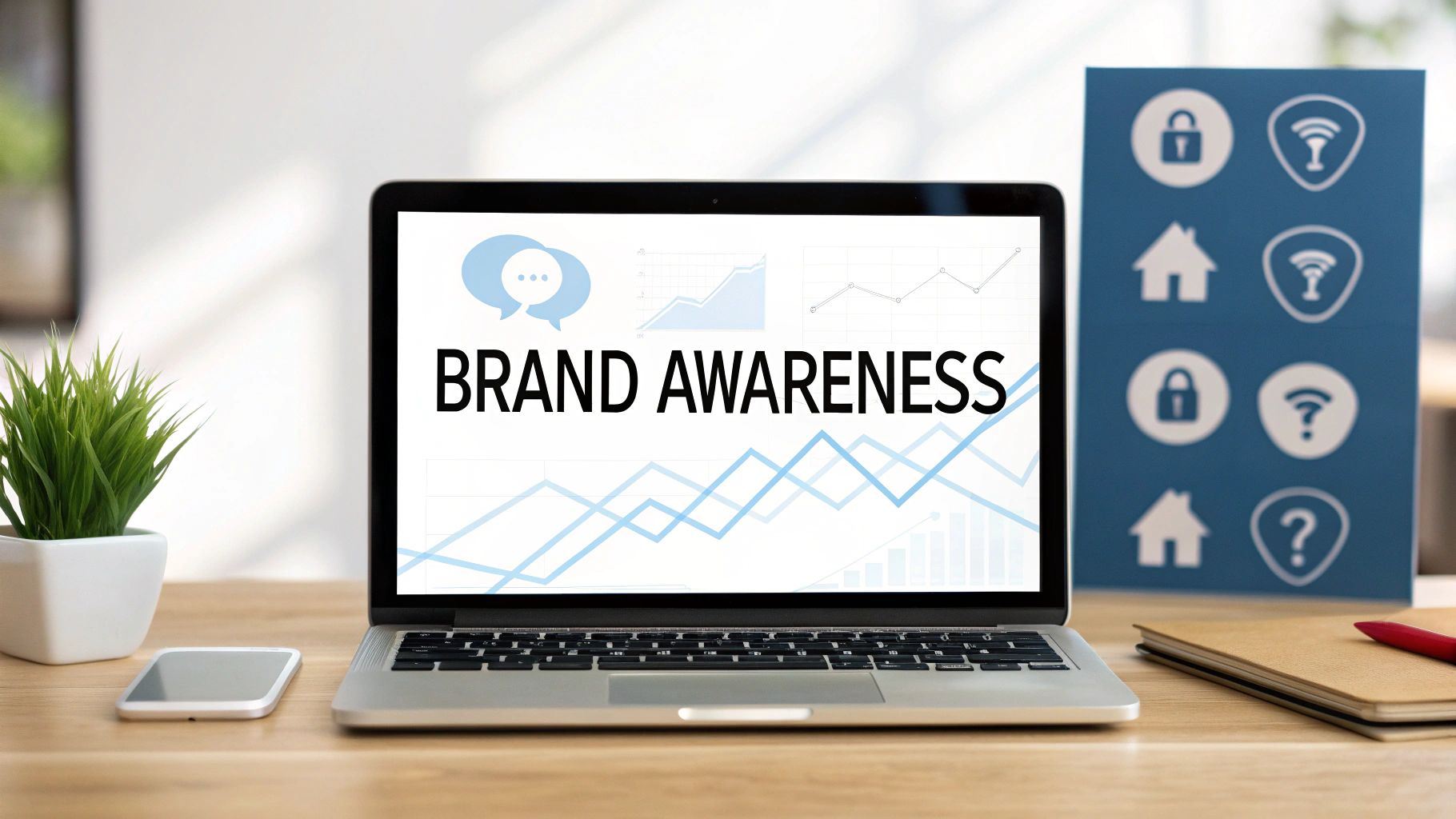
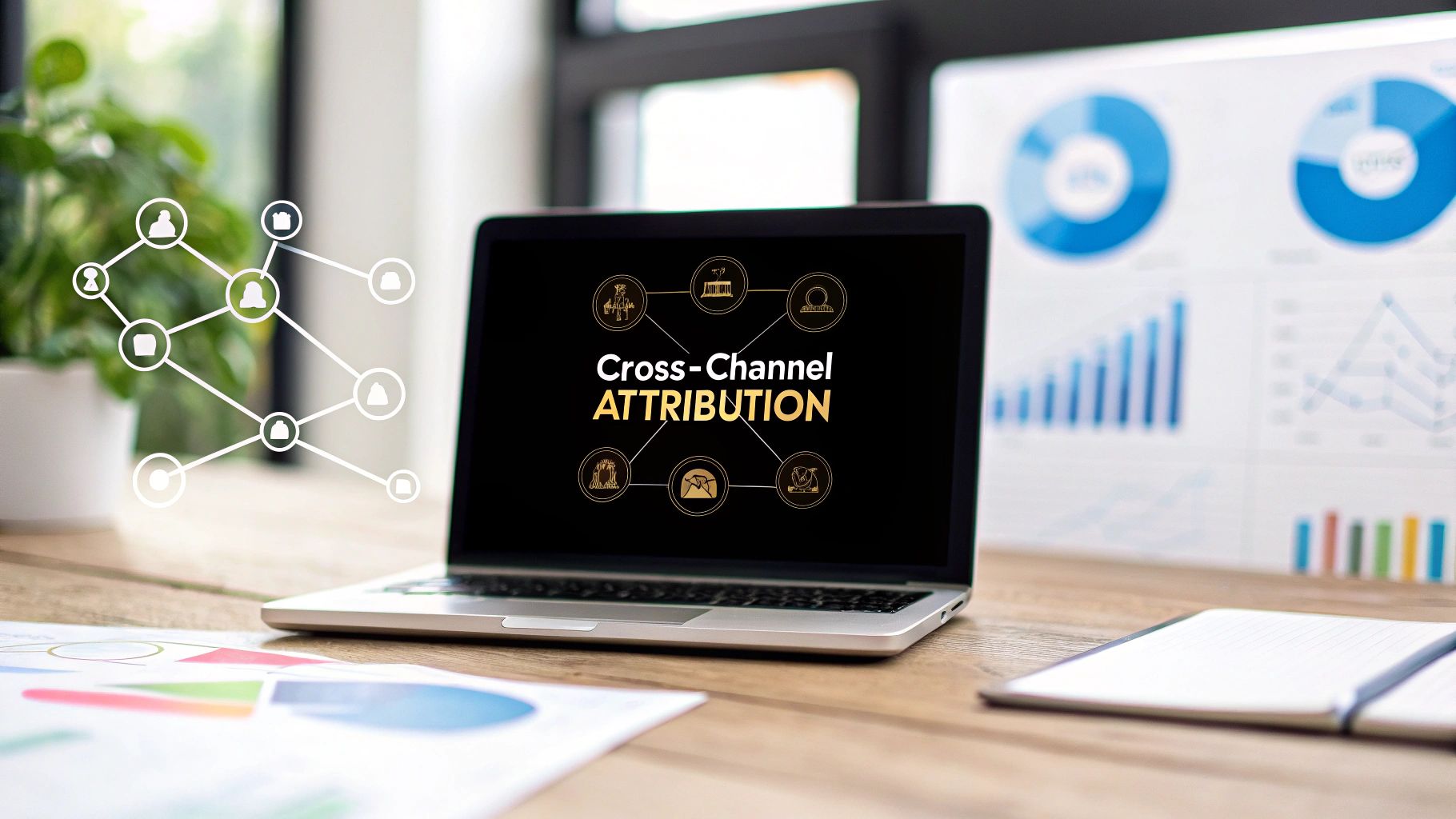
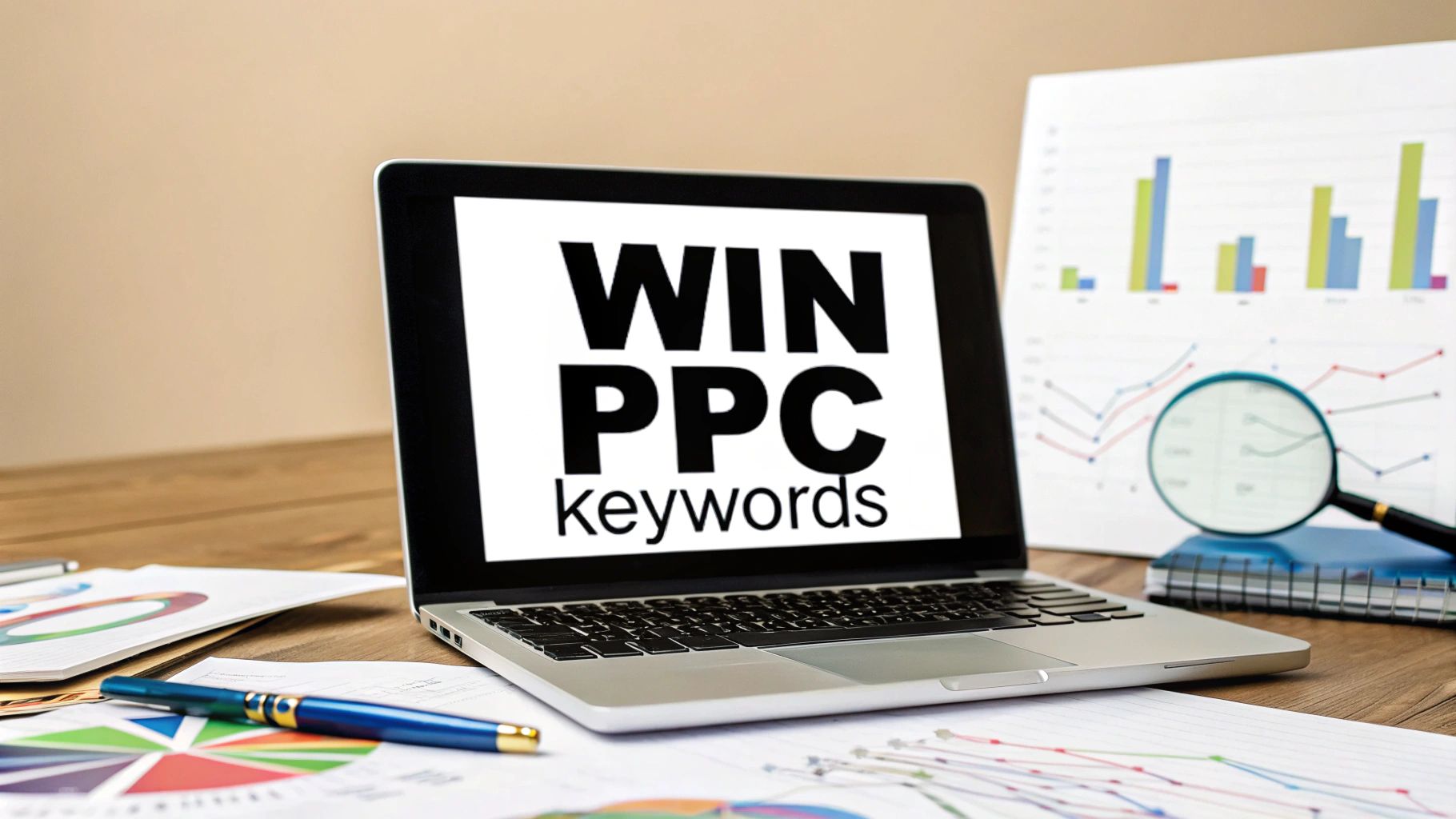
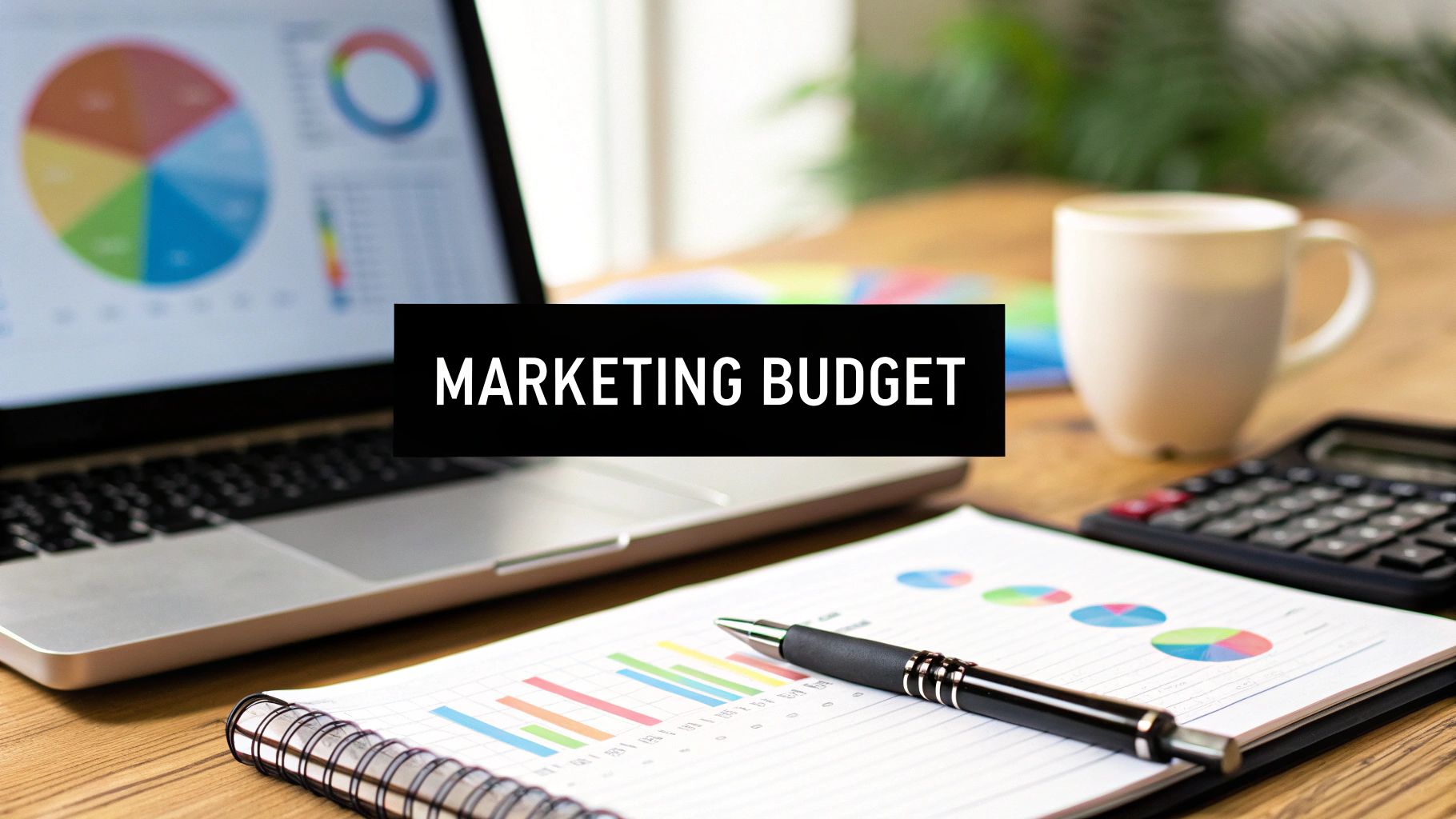
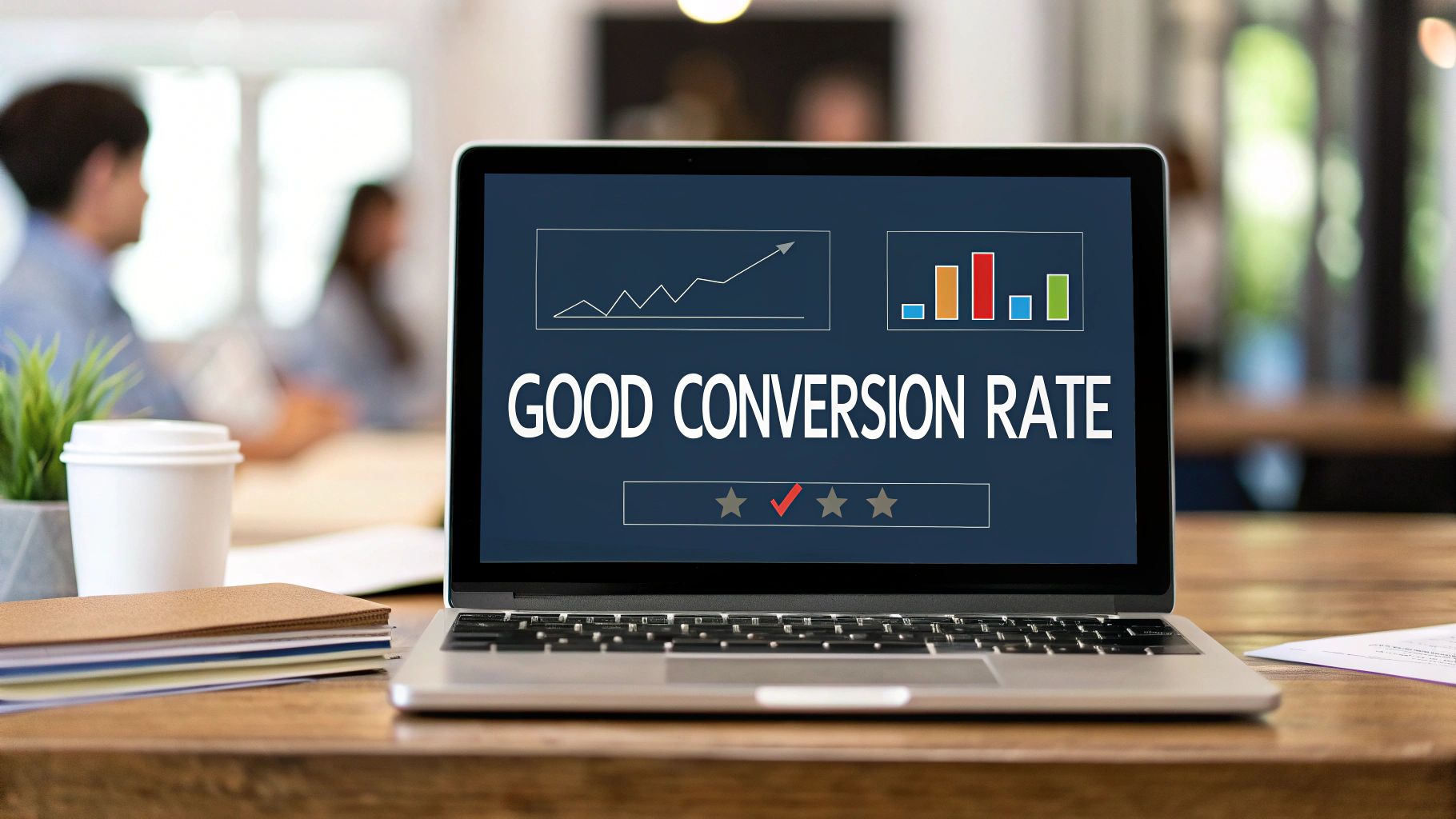
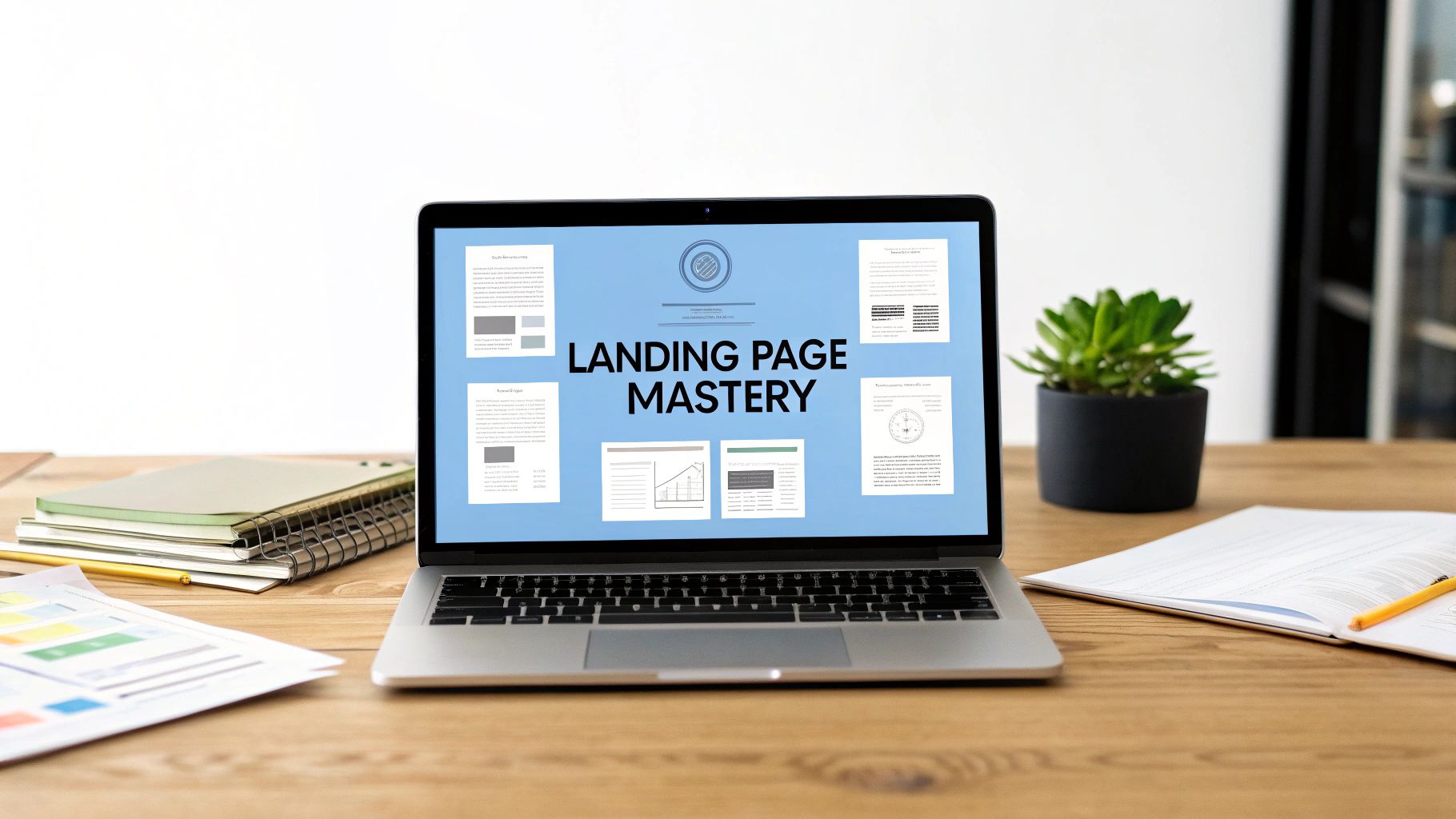
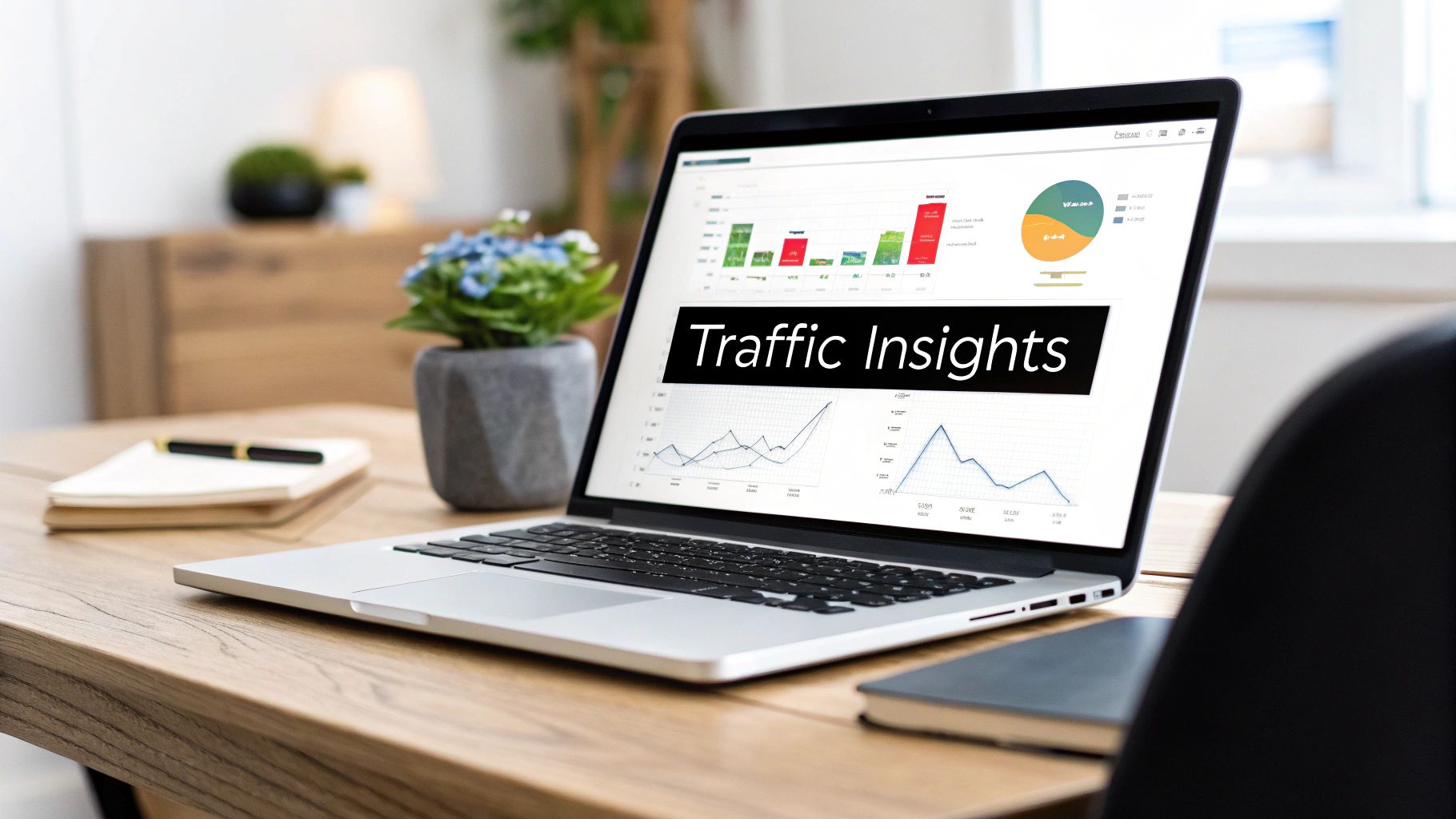
Comments